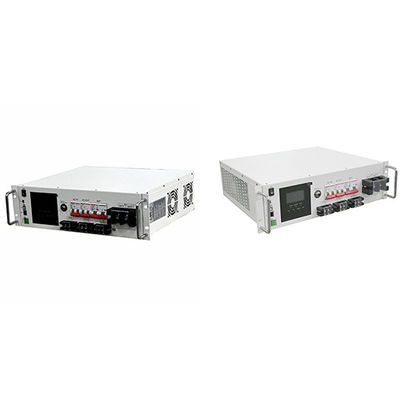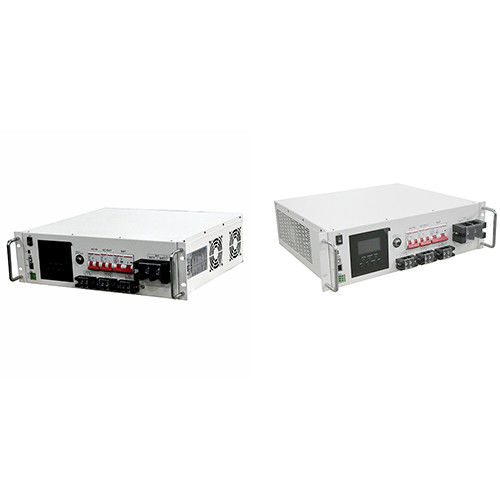
RS485 50/60Hz PV Hybrid Solar Inverter DSP Grid With Lithium Battery
-
High Light
60Hz PV Hybrid Solar Inverter
,RS485 Hybrid Solar Inverter
,DSP Grid Solar Power Inverter
-
ColorWhite
-
Frequency50Hz/ 60Hz (automatic Detection)
-
Battery TypeLead Acid Or Lithium Battery
-
Efficiency>95%
-
Communicat Ion InterfaceUSB/RS485 (WiFi/GPRS)/Dry Node Control
-
Size482*425*133mm
-
Place of OriginShenZhen, China
-
Brand NameCONSNANT
-
CertificationCE(EN62109); EN61000; C2
-
Model NumberHT4830S80-145 | HT4840S80-145 | HT4850S80-145 | HT4825U80-145 | HT4830U80-145 | HT4835U80-145
-
Minimum Order Quantity20 Pieces
-
PriceNegotiable
-
Packaging DetailsExport Standard Package
-
Delivery Time5-8 days for sample order, 15-21 days for large quantity
-
Payment TermsL/C, T/T, Western Union
-
Supply Ability1000 pieces per month
RS485 50/60Hz PV Hybrid Solar Inverter DSP Grid With Lithium Battery
Mutiple Mode Hybrid PV Energy Storage Grid Solar Inverter
Product Instruction:
HT series is a new hybrid PV energy storage inverter controller integrating PV energy storage,mains charging
and storage and AC sine wave output. Using DSP control through advanced control algorithms, it comes with high
response speed, high reliability, high industrialization standard and other characteristics.
Four charging modes are available: only PV, mains priority, PV priority, and hybrid charging by mains & PV;
two output modes: inverter and mains are available to meet different application needs.
Specification Reference:
| Model | HT4830S80-145 | HT4840S80-145 | HT4850S80-145 | HT4825U80-145 | HT4830U80-145 | HT4835U80-145 |
| Mains mode | ||||||
| Rated input voltage | 220/230Vac | 110/120Vac | ||||
| Input voltage range | (170Vac~280Vac) ±2% (90Vac-280Vac)±2% |
(90Vac~140Vac) ±2% | ||||
| Frequency range | 47±0.3Hz ~ 55±0.3Hz (50Hz); 57±0.3Hz ~ 65±0.3Hz (60Hz); |
|||||
| Conversion time | 10ms (typical) | |||||
| (bypass and inverter) | ||||||
| Maximum bypass overload current | 40A | |||||
| Inverter mode | ||||||
| Output voltage waveform | Pure sine wave | |||||
| Rated output power (VA) | 3000(2600/2700 /3000) |
4000(3480/360 3800/4000) |
5000(4350/4500 /4800/5000) |
2500(2000/2180 /2290) |
3000(2500/2600 /2750) |
3500(2900/3000 /3200) |
| Rated output power (W) | 3000(2600/2700 /3000) |
4000(3480/360 3800/4000) |
5000(4350/4500 /4800/5000) |
2500(2000/2180 /2290) |
3000(2500/2600 /2750) |
3500(2900/3000 /3200) |
| Rated output voltage (Vac) | 230Vac(200/208/220/240Vac Settable) | 120Vac(100/105/110Vac Settable) | ||||
| Output voltage error | ±5% | |||||
| Output frequency range (Hz) | 50Hz ± 0.3Hz 60Hz ± 0.3Hz |
|||||
| Efficiency | >92% | >91% | ||||
| Overload protection | (102%<load<125%) ±10%: Report error and turn off output after 5 minutes; (125%<load<150%) ±10%: Report error and turn off output after 10 seconds; Load>150% ±10%: Report error and turn off output after 5 seconds; |
(102%<load<110%) ±10%: Report error and turn off output after 5 minutes; (110%<load<125%) ±10%: Report error and turn off output after 10 seconds; Load>125% ±10%: Report error and turn off output after 5 seconds; |
||||
| Peak power | 6000VA | 8000VA | 10000VA | 4000VA | 4500VA | 5000VA |
| Loaded motor capacity | 2HP | 3HP | 4HP | 1HP | 2HP | 2HP |
| Bypass circuit breaker specification | 63A | |||||
| Rated battery input voltage | 48V (minimum starting voltage 44V) | |||||
| Battery voltage range | 40.0Vdc~60Vdc ± 0.6Vdc (undervoltage alarm / shutdown voltage / overvoltage alarm / overvoltage recovery...LCD screen can be set) | |||||
| Eco mode | Load ≤ 50W | |||||
| AC charging | ||||||
| Maximum charge current | 0-60A | 0-40A | ||||
| Charge current error |
± 5Adc | |||||
| Charge voltage range | 40 - 58Vdc | 40 - 60Vdc | ||||
| Circuit breaker specification | (AC IN) 63A/(BAT) 125A | |||||
| PC charge | ||||||
| Maximum PV open circuit voltage | 145Vdc | |||||
| PV operating voltage range | 60-145Vdc | |||||
| MPPT voltage range | 60-115Vdc | |||||
| Battery voltage range | 40-60Vdc | |||||
| Maximum output power | 4200W | |||||
| PV charge current range (settable) | 0-80A | |||||
| Charge short circuit protection | BAT circuit breaker and fuse | |||||
| Wiring protection | Reverse polarity protection | |||||
| Hybrid charging Max charger current specifications (AC charger+PV charger) | ||||||
| Max charger current(can be set) | 0-140A | 0-120A | ||||
| Certified specification | ||||||
| Specification certification | CE(EN62109) | |||||
| EMC certification level | EN61000, C2 | |||||
| Operating temperature range | -15°C to 55°C | |||||
| Storage temperature range | -25°C ~ 60°C | |||||
| RH range | 5% to 95% (conformal coating protection) | |||||
| Noise | ≤60dB | |||||
| Heat dissipation | Forced air cooling, adjustable air speed | |||||
Product Maintenance:
| No. | Protections | Remarks |
| 1 | PV current/power limiting protection | When charging current or power of the PV array configured exceeds the PV rated, it will charge at the rated. |
| 2 | PV night reverse-current protection | At night, the battery is prevented from discharging through the PV module because the battery voltage is greater than the voltage of PV module. |
| 3 | Mains input over voltage protection | When the mains voltage exceeds 280V (230V model) or 140V (120V model), the mains charging will be stopped and switched to the inverter mode. |
| 4 | Mains input under voltage protection |
When the mains voltage is lower than 170V (230V model /UPS mode) or 90V (120V model or APL mode), the mains charging will be stopped and switched to the inverter mode. |
| 5 | Battery over voltage protection | When the battery voltage reaches the overvoltage disconnection point, the PV and the mains will be automatically stopped to charge the battery to prevent the battery from being overcharged and damaged. |
| 6 | Battery low voltage protection | When the battery voltage reaches the low voltage disconnection point, the battery discharging will be automatically stopped to prevent the battery from being over-discharged and damaged. |
| 7 | Load output short circuit protection | When a short-circuit fault occurs at the load output terminal, the AC output is immediately turned off and turned on again after 1 second. |
| 8 | Heat sink over temperature protection | When the internal temperature is too high, the all-in-one machine will stop charging and discharging; when the temperature returns to normal, charging and discharging will resume. |
| 9 | Overload protection | Output again 3 minutes after an overload protection, and turn the output off after 5 consecutive times of overload protection until the machine is re-powered. For the specific overload level and duration, refer to the technical parameters table in the manual. |
| 10 | PV reverse polarity protection | When the PV polarity is reversed, the machine will not be damaged. |
| 11 | AC reverse protection | Prevent battery inverter AC current from being reversely input to Bypass. |
| 12 | Bypass over current protection | Built-in AC input overcurrent protection circuit breaker. |
| 13 | Battery input over current protection | When the discharge output current of the battery is greater than the maximum value and lasts for 1 minute, the AC input would switched to load. |
| 14 | Battery input protection | When the battery is reversely connected or the inverter is short-circuited, the battery input fuse in the inverter will blow out to prevent the battery from being damaged or causing a fire. |
| 15 | Charge short protection | When the external battery port is short-circuited in the PV or AC charging state, the inverter will protect and stop the output current. |
![]()
Fault Handling:
| No. | Faults | Handling measures |
| 1 | No display on the screen | Check if the battery air switch or the PV air switch has been closed; if the switch is in the "ON" state; press any button on the screen to exit the screen sleep mode. |
| 2 | Battery overvoltage protection | Measure if the battery voltage exceeds rated, and turn off the PV array air switch and Mains air switch. |
| 3 | Battery undervoltage protection | Charge the battery until it returns to the low voltage disconnection recovery voltage. |
| 4 | Fan failure | Check if the fan is not turning or blocked by foreign object. |
| 5 | Heat sink over temperature protection | When the temperature of the device is cooled below the recovery temperature, normal charge and discharge control is resumed. |
| 6 | Bypass overload protection, inverter overload protection | ① Reduce the use of power equipment; ② Restart the unit to resume load output. |
| 7 | Inverter short circuit protection | ① Check the load connection carefully and clear the short-circuit fault points; ② Re-power up to resume load output. |
| 8 | PV overvoltage | Use a multimeter to check if the PV input voltage exceeds the maximum allowable input voltage rated. |
| 9 | Battery missed alarm | Check if the battery is not connected or if the battery circuit breaker is not closed. |
